|
Potted Raspberry Bushes For Sale
|
|
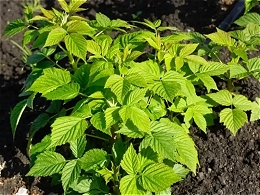
Black Raspberry
|
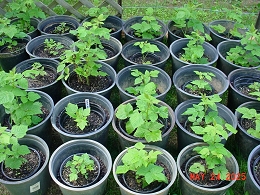
Nova Raspberry
|
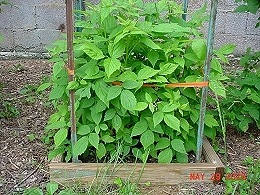
Heritage Raspberry
|
Raspberry Bushes
All of our potted Nova, Heritage, Black, and Willamette raspberry bushes are started from cuttings or suckers off our raspberry bushes growing on our property and are ready for transplant.
A potted raspberry bush can be transplanted into the ground almost any time of the year since their root system is barely disturbed with little or no stress when transplanted from a pot. Transplant these raspberry bushes tomorrow or grow these raspberry bushes in the existing pot for up to one year.
Raspberries offer a variety of health benefits due to their high content of fiber, vitamins, and antioxidants very similar to blackberries, strawberries, and blueberries.
Raspberries can be enjoyed in various ways, such as in smoothies, yogurt bowls, oatmeal, salads, and baked goods, making them a versatile and nutritious addition to your diet.
Raspberries are great for eating fresh, canning, freezing, or making jams and jellies can be used in a variety of desserts and other recipes.
Grow an abundance of raspberries and freeze plenty to enjoy throughout the year. It is easy to freeze raspberries and they are just as tasty and beneficial as freshly picked raspberries.
In times of need, a neighbor growing raspberries may be a friend indeed!
About Raspberry Bushes
There are two main categories of raspberries; summer-bearing and fall-bearing. Some varieties are bush like, compact, and short (2'-3') while some varieties are more spreading, upright, and tall (5'-6'). Raspberries only produce fruit on their second year, so if you see a red cane, possibly with a white chalky look to it, it will most likely be the one to bear fruit, whereas the green, first year cane has only begun to grow, but will still display the same style of leaves and flowers. After the second year cane is done producing, it will die and typically look dead and dry. New canes with appear every year, old canes should be cut back and removed.
Plant raspberry bushes 3-4 feet apart and install a post and wire system for support for the taller growing varieties. Water raspberry bushes regularly during the summer, cut back on watering during the winter. Raspberries are usually planted in rows and trained along a post and wire system. But, if you have a smaller garden, you can still grow raspberries, either in containers or trained up a single post. Feed raspberry bushes in the spring through early July. Harvest (pick the raspberries) regularly to encourage the plants to produce a higher yield.
Spring and fall is a good time to plant or transplant raspberries. Prune in summer immediately after fruiting. Cut back the tips of everbearers that fruited last fall (top 1/3 of the canes) but leave the rest of the cane for summer fruiting. Remove the canes completely after they have fruited over their entire length to encourage the production of new canes. Promptly remove excess new plants and suckers to control spread. In late winter, remove any canes damaged by winter and thin, as needed, the remaining canes. Propagate from suckers and first year cuttings.
|
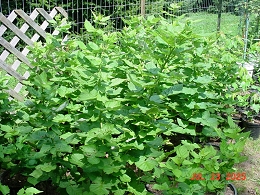
Nova Raspberry
|
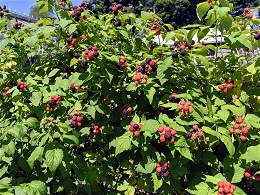
Nova Raspberry
|
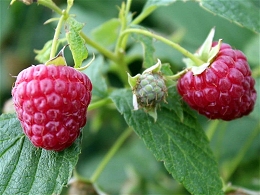
Nova Raspberry
|
'Nova' Raspberry (Rubus idaeus)
|
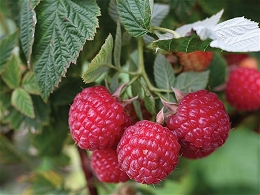
Nova Raspberry
|
Upright growing with an abundance of large sized raspberries. Nova Raspberry is cold-hardy and reliable and produces large dark red raspberries. Nova Raspberry is a summer bearing raspberry and early season cultivar that is vigorous and upright with long, fruiting laterals producing very large raspberries with some raspberry production in the fall. Nova Raspberry canes have very few spines, making picking pleasant. Clusters of white, rose-like flowers give way to medium-sized, bright red, firm raspberries which ripen in early summer.
Nova Raspberry is resistant to most common cane diseases and grows up to 6' tall and 3' wide. A full sun to part shade lover, this plant is best grown in organically rich, slightly acidic, moist but well-drained soils. Raspberries dislike waterlogged soils and shallow chalky soils. For best results, plant in a sheltered, sunny position. Nova Raspberry will tolerate light shade, but the yield is likely to be reduced.
'Heritage' Raspberry (Rubus idaeus)
|

Heritage Raspberry
|
Bush like growing with an abundance of medium sized raspberries. Heritage Raspberry is an everbearing variety, meaning it produces a crop in both summer and fall and known for their sweet, dark red raspberries.
Heritage Raspberry is a hardy and easy-to-grow variety that produces a bountiful harvest. Heritage Raspberry is a fast-growing and prolific plant that produces fruit in summer and again in fall. Heritage Raspberry is also known for its resistance to many major raspberry diseases.
|
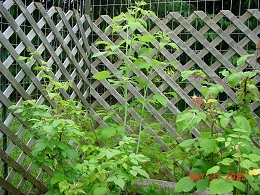
Black Raspberry
|

Black Raspberry
|
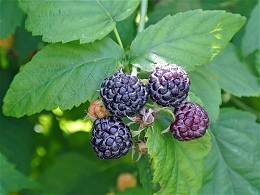
Black Raspberry
|
'Black' Raspberry (Rubus occidentalis)
|
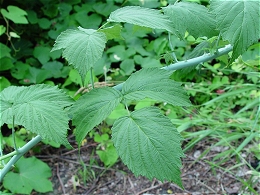
Black Raspberry
|
Black Raspberry bushes are summer-bearing raspberry bushes, meaning they fruit on the previous year's growth, typically in late spring or early summer.
Black Raspberry bushes are thorny, perennial bramble plants (Rubus occidentalis) that produce young whitish canes and dark purple or black raspberries. It is related to both raspberries and blackberries, known for its sweet yet slightly tart flavor and smaller, more delicate berries. Black raspberries are typically harvested in summer and require proper sunlight, well-drained soil. Black raspberry bushes have blue-green stems, long canes, and require almost no maintenance. They typically grow 5-10 feet tall and about 5' wide. Black raspberries have a distinct sweet yet slightly tart flavor, making them a popular choice for jams, jellies, pies, and desserts. They are known for their rich antioxidant content and potential anti-inflammatory and anti-cancer properties.
The new canes of Black Raspberries are often characterized by a whitish-coated appearance when young, which can rub off. This whitish coating is a glaucous bloom, and is a common feature of Rubus occidentalis (Black Raspberry). The canes will eventually mature to a bluish-green or purple color, especially in winter.
Black raspberries have thorns, which are broad-based and recurved.
The new canes (primocanes, first year canes) emerge from the ground or crown of the plant are initially green and smooth.
These first year canes have a whitish coating (glaucus bloom) that rubs off easily.
The new canes will mature to a purple or bluish-green color, especially in winter.
The new canes (floricanes, second year canes) produce fruit and are typically more rigid and mature in color.
'Willamette' Raspberry (Rubus idaeus)
|
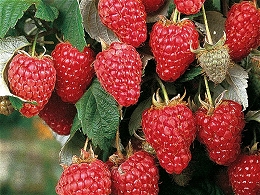
Willamette Raspberry
|
The Willamette raspberry is a classic summer-bearing variety, meaning it produces fruit on canes from the previous year, typically ripening in mid-summer.
Willamette raspberry is a deciduous, self-fertile, semi-trailing floricane raspberry variety known for its heavy yield of firm, medium-sized, dark red berries that ripen in mid-summer (June-July) and are great for fresh eating, cooking, baking, preserves (jams, jellies), canning, and freezing.
Willamette raspberry grows upright canes that produce small white flowers in the spring, followed by fruit, firm, medium-sized, dark red berries sweet and tart flavor with juicy texture.
Willamette raspberry thrives on full sun to partial shade, well-drained loamy soil, with moderate watering, and fertilized in the spring. Mature height is about 4 to 5 feet with a spread of 3 to 4 feet wide.
Raspberry Health Benefits
Raspberries offer a variety of health benefits due to their high content of fiber, vitamins, and antioxidants. They are particularly beneficial for heart health, diabetes management, and skin health. Raspberries contain antioxidants like vitamin C and ellagic acid, which can help prevent oxidative damage and reduce the risk of diseases such as heart disease, diabetes, obesity, and cancer.
Raspberries are a good source of fiber and vitamin C and contain small amounts of manganese, omega-3 fatty acids, vitamin A, thiamine, riboflavin, vitamin B6, calcium, and zinc. They also provide potassium, essential to heart function, and proven to lower blood pressure. The raspberry leaves can be used to make a surprisingly delicious health beneficial tea. Raspberry health benefits are very similar to blackberry health benefits.
One cup of raspberries provides 8 grams of fiber, which can help lower blood sugar, cholesterol, and blood pressure. This high fiber content also makes raspberries more satisfying and can aid in weight management.
Raspberries are low in sugar, containing just 5 grams in an entire cup, making them less likely to raise blood sugar levels. They are rich in vitamin C, providing half the recommended daily value, which is essential for immune function and iron absorption.
Raspberries may help alleviate symptoms of arthritis and reduce signs of aging due to their anti-inflammatory properties and high antioxidant content.
Raspberries are also beneficial for gut health because of their high fiber content, although consuming too much fiber too quickly can cause stomach issues like gas and bloating.
How To Prune Raspberry Bushes
Pruning is not only an important part of proper raspberry plant care and maintenance, it is also a way to ensure and improve the development of the fruit crop. Pruning raspberry bushes involves removing old canes to make way for new growth and to improve fruit production. The timing and method of pruning depend on the type of raspberry bush.
Not everyone will prune the exact same way - including the experts. It is preferable to do some pruning rather than no pruning. If a raspberry plant is left unpruned, it may become tangled and overgrown and may even be unfruitful as a result.
Pruning may vary depending on the raspberry varieties you plant. The best approach is to understand the bearing nature of the varieties you are growing so you know how to prune when the time comes. That said, regardless of growth habit, some pruning should be done every spring to keep raspberry plants from becoming tangled and to improve their ability to bear. Consider staking or trellis-training your raspberry plants to keep them more upright.
For floricane-bearing raspberry plants also known as "summer-bearing" raspberries, which produce fruit on the previous year's growth, prune in early spring before new growth appears. Remove all weak, broken, and diseased canes, and thin the remaining canes to about 6 to 8 inches apart and prune young canes back until they are around 4 to 5 feet tall to ensure good air circulation and sunlight penetration which will improve fruit production and quality. After the summer harvest, cut back the old floricanes (canes that have already produced fruit) to the ground.
For primocane-bearing raspberry plants also known as "everbearing" or "fall-bearing" raspberries, you have two options: If you want a single large fall crop, cut all the canes to the ground in early spring. If you want both a summer and fall crop, prune in late winter or early spring to remove old canes and thin the remaining canes. After the fall harvest, cut back the canes that have produced fruit.
In general, it is best to prune in early spring to avoid disturbing new growth and to allow the plant to benefit from the carbohydrate reserves stored in the old canes during dormancy. If you have an overgrown raspberry patch, you can cut it back to a few inches from the ground in the spring to reset it to a healthy state. This method is particularly effective for everbearing raspberries. Regular pruning helps maintain a healthy, productive raspberry patch by preventing overcrowding and promoting air circulation, which can reduce the risk of fungal diseases.
|